Assessing Heatwaves and Their Association with North African Dust Intrusions in the Algarve (Portugal)
Abstract
:1. Introduction
2. Materials and Methods
2.1. Study Area
2.2. Materials
2.2.1. Daily Air-Temperature Data
2.2.2. Saharan Dust Events (APA Inventory)
2.2.3. Air-Quality Station Data: PM10 Daily/Hourly Legal Exceedances
2.3. Methods
2.3.1. Excess Heat Factor (EHF)
2.3.2. Heatwave Trends (Frequency, Duration, and EHF Load)
2.3.3. K-Means
3. Results
3.1. Heatwaves: Trend Analyses
3.2. Air-Quality Deterioration during Heatwaves
SDE Inventory
3.3. PM10 Legal Exceedances during SDE
3.4. Atmospheric Patterns
4. Discussion
4.1. Heatwaves
4.2. Saharan Dust Events (SDE)
4.3. Atmospheric Patterns of Heatwave and Dust Days
5. Conclusions
Author Contributions
Funding
Institutional Review Board Statement
Informed Consent Statement
Data Availability Statement
Acknowledgments
Conflicts of Interest
References
- Meehl, G.; Tebaldi, C. More intense, more frequent, and longer lasting heat waves in the 21st century. Science 2004, 305, 994–997. [Google Scholar] [CrossRef] [PubMed] [Green Version]
- Perkins, S. Review on the scientific understanding of heatwaves—Their measurement, driving mechanisms, and changes at the global scale. Atmos. Res. 2015, 164, 242–267. [Google Scholar] [CrossRef]
- DGS. Plano de Contingência Para Temperaturas Extremas Adversas. In Módulo Calor 2014; Divisão de Saúde Ambiental e Ocupacional, Direção de Serviços de Prevenção da Doença e Promoção da Saúde: Lisboa, Portugal, 2014. [Google Scholar]
- D’Ippoliti, D.; Michelozzi, P.; Marino, C.; de’Donato, F.; Menne, B.; Katsouyanni, K.; Kirchmayer, U.; Analitis, A.; Medina-Ramón, M.; Paldy, A.; et al. The impact of heat waves on mortality in 9 European cities: Results from the EuroHEAT project. Environ. Health 2010, 16, 9–37. [Google Scholar] [CrossRef] [Green Version]
- IPCC. Managing the Risks of Extreme Events and Disasters to Advance Climate Change Adaptation: A Special Report of Working Groups I and II of the Intergovernmental Panel on Climate Change; Cambridge University Press: Cambridge, UK; New York, NY, USA, 2012; p. 582. [Google Scholar]
- Stafoggia, M.; Forastiere, F.; Agostini, D.; Biggeri, A.; Bisanti, L.; Cadum, E.; Caranci, N.; de’ Donato, F.; de Lisio, S.; de Maria, M.; et al. Vulnerability to heat-related mortality: A multicity, population-based, case-crossover analysis. Epidemiolog 2006, 17, 315–323. [Google Scholar] [CrossRef]
- Kovats, R.; Ebi, K. Heatwaves and public health in Europe. Eur. J. Public Health 2006, 16, 592–599. [Google Scholar] [CrossRef] [Green Version]
- Nitschke, M.; Tucker, G.; Hansen, A.; Williams, S.; Zhang, Y.; Bi, P. Impact of two recent extreme heat episodes on morbidity and mortality in Adelaide, South Australia: A case-series analysis. Environ. Health 2011, 10, 42. [Google Scholar] [CrossRef] [PubMed] [Green Version]
- Son, J.; Lee, J.; Anderson, G.; Michelle, L. The Impact of Heat Waves on Mortality in Seven Major Cities in Korea. Environ. Health Perspect. 2012, 120, 566–571. [Google Scholar] [CrossRef] [Green Version]
- Paixão, E.; Nogueira, P. Efeitos de uma onda de calor na mortalidade. Rev. Port. Saúde Pública 2003, 21, 41–54. [Google Scholar]
- Calado, R.; Nogueira, P.; Catarino, J.; Paixão, E.; Botelho, J.; Carreira, M.; Falcão, J. A onda de calor de agosto de 2003 e os seus efeitos sobre a mortalidade da população portuguesa. Rev. Port. Saúde Pública 2004, 22, 7–20. [Google Scholar]
- Nogueira, P.; Falcão, J.; Contreiras, M.; Paixão, E.; Brandão, J.; Batista, I. Mortality in Portugal associated with the heat wave of August 2003: Early estimation of effect, using a rapid method. Eurosurveillance 2005, 10, 553. [Google Scholar] [CrossRef]
- Nairn, J.; Fawcett, R.; Ray, D. Defining and predicting excessive heat events: A national system. In Proceedings of the Modelling and Understanding High Impact Weather: Extended Abstracts of the Third CAWCR Modelling Workshop, Melbourne, Australia, 30 November–2 December 2009; Volume 17, pp. 83–86. [Google Scholar]
- Tolika, K. Assessing Heat Waves over Greece Using the Excess Heat Factor (EHF). Climate 2019, 7, 9. [Google Scholar] [CrossRef] [Green Version]
- Urban, A.; Hanzlíková, H.; Kyselý, J.; Plavcová, E. Impacts of the 2015 heat waves on mortality in the Czech Republic—A comparison with previous heat waves. Int. J. Environ. Res. Public Health 2017, 14, 1562. [Google Scholar] [CrossRef] [Green Version]
- Pascal, M.; Wagner, V.; Alari, A.; Corso, M.; Tertre, A. Extreme heat and acute air pollution episodes: A need for joint public health warnings? Atmos. Res. 2021, 249, 118249. [Google Scholar]
- Pey, J.; Querol, X.; Alastuey, A.; Forastiere, F.; Stafoggia, M. African dust outbreaks over the Mediterranean Basin during 2001–2011: PM10 concentrations, phenomenology and trends, and its relationship with synoptic and mesoscale meteorology. Atmos. Chem. Phys. 2013, 13, 1395–1410. [Google Scholar] [CrossRef] [Green Version]
- Díaz, J.; Linares, C.; Carmona, R.; Russo, A.; Ortiz, C.; Salvador, P.; Trigo, R. Saharan dust intrusions in Spain: Health impacts and associated synoptic conditions. Environ. Res. 2017, 156, 455–467. [Google Scholar] [CrossRef] [PubMed]
- Waters, S.; Armstrong, R.; Detres, Y. Metagenomic investigation of African dust events in the Caribbean. FEMS Microbiol. Lett. 2020, 367, fnaa051. [Google Scholar] [CrossRef] [PubMed]
- Fischer, P.; Brunekreef, B.; Lebret, E. Air pollution related deaths during the 2003 heat wave in the Netherlands. Atmos. Environ. 2004, 38, 1083–1085. [Google Scholar] [CrossRef]
- Stedman, J. The predicted number of air pollution related deaths in the UK during the August 2003 heatwave. Atmos. Environ. 2004, 38, 1087–1090. [Google Scholar] [CrossRef]
- Russo, A.; Sousa, P.; Durão, R.; Ramos, A.; Salvador, P.; Linares, C.; Díaz, J.; Trigo, R. Saharan dust intrusions in the Iberian Peninsula: Predominant synoptic conditions. Sci. Total Environ. 2020, 717, 137041. [Google Scholar] [CrossRef]
- Silva, T.; Fragoso, M.; Almendra, R.; Vasconcelos, J.; Lopes, A.; Faleh, A. North African dust intrusions and increased risk of respiratory diseases in Southern Portugal. Int. J. Biometeorol. 2021. [Google Scholar] [CrossRef]
- Statistics Portugal—Tourism Statistics. Available online: https://www.ine.pt/xportal/xmain?xpgid=ine_tema&xpid=INE&tema_cod=1713 (accessed on 6 July 2021).
- Conti, S.; Meli, P.; Minelli, G.; Solimini, R.; Taccaceli, V.; Vichi, M.; Beltrano, C.; Perini, L. Epidemiologic study of mortality during the Summer 2003 heat wave in Italy. Environ. Res. 2005, 98, 390–399. [Google Scholar] [CrossRef]
- Tan, J.; Zheng, Y.; Song, G.; Kalkstein, L.; Kalkstein, A.; Tang, X. Heat waves impacts on mortality in Shanghai, 1998 and 2003. Int. J. Biometeorol. 2007, 51, 193–200. [Google Scholar] [CrossRef] [PubMed]
- Li, M.; Gu, S.; Peng, B.; Yang, J.; Qiyong, L. Heat waves and morbidity: Current knowledge and futher direction—A comprehensive literature review. Environ. Res. Public Health 2015, 12, 5256–5283. [Google Scholar] [CrossRef] [PubMed] [Green Version]
- Ferreira, D. Oambiente Climático in Geografia de Portugal 1; Círculo de Leitores: Lisboa, Portugal, 2005. [Google Scholar]
- Cunha, L. Riscos climáticos no Centro de Portugal. Uma leitura geográfica. Rev. Geonorte 2012, 4, 105–115. [Google Scholar]
- Trigo, R.; Ramos, A.; Nogueira, P.; Santos, F.; Garcia-Herrera, R.; Gouveia, C.; Santo, F. Evaluating the impact of extreme temperature-based indices in the 2003 heatwave excessive mortality in Portugal. Environ. Sci. Policy 2009, 12, 844–854. [Google Scholar] [CrossRef]
- Sousa, P.; Barriopedro, D.; Ramos, A.; García-Herrera, R.; Espírito-Santo, F.; Trigo, R. Saharan air intrusions as a relevant mechanism for Iberian heatwaves: The record-breaking events of August 2018 and June 2019. Weather Clim. Extrem. 2019, 26, 100224. [Google Scholar] [CrossRef]
- Ferreira, F.; Monjardino, J.; Mendes, L. Identificação e Avaliação de Eventos Naturais no ano de 2015; Report; Agência Portuguesa do Ambiente: Amadora, Portugal, 2016. [Google Scholar]
- Decree—Law 102/2010 of 23 September of the Committee on the Environment and Territorial Planning. Diário da República: I Série, Nº 186. 2010. Available online: https://data.dre.pt/eli/dec-lei/102/2010/09/23/p/dre/pt/html (accessed on 1 April 2021).
- Nairn, J.; Fawcett, R. The Excess Heat Factor: A Metric for Heatwave Intensity and Its Use in Classifying Heatwave Severity. Environ. Res. Public Health 2015, 12, 227–253. [Google Scholar] [CrossRef] [PubMed] [Green Version]
- Barbieri, L.; Correia, M.; Aragão, M.; Vilar, R.; Moura, M. Impact of Climate Variations and Land Use Change: A Mann-Kendall Application. Rev. Geama 2017, 3, 127–135. [Google Scholar]
- Christiansen, B. Atmospheric Circulation Regimes: Can Cluster Analysis Provide the Number? J. Clim. 2007, 20, 2229–2250. [Google Scholar] [CrossRef]
- Salvador, P.; Alonso-Pérez, S.; Pey, J.; Artíñano, B.; de Bustos, J.; Alastuey, A.; Querol, X. African dust outbreaks over the western Mediterranean Basin: 11-year characterization of atmospheric circulation patterns and dust source areas. Atmos. Chem. Phys. 2014, 14, 6759–6775. [Google Scholar] [CrossRef] [Green Version]
- Alonzo-Pérez, S.; Cuevas, E.; Querol, X. Objective identification of synoptic meteorological patterns favouring African dust intrusions into the marine boundary layer of the subtropical eastern north Atlantic region. Meteorol. Atmos. Phys. 2011, 113, 109–124. [Google Scholar] [CrossRef]
- Huerta-Viso, A.; Crespo, J.; Galindo, N.; Yubero, E.; Nicolás, J. Saharan Dust Events over the Valencian Community (Eastern Iberian Peninsula): Synoptic Circulation Patterns and Contribution to PM10 Levels. Aerosol Air Qual. Res. 2020, 20, 2519–2528. [Google Scholar] [CrossRef]
- Ferreira, F.; Monjardino, J.; Mendes, L. Identificação e Avaliação de Eventos Naturais no ano de 2018; Report; Agência Portuguesa do Ambiente: Amadora, Portugal, 2018. [Google Scholar]
- Ferreira, F.; Monjardino, J. Identificação e Avaliação de Eventos Naturais no ano de 2010; Report; Agência Portuguesa do Ambiente: Amadora, Portugal, 2011. [Google Scholar]
- Perkins, S.; Alexander, L.; Nairn, J. Increasing frequency, intensity and duration of observed global heatwaves and warm spells. Geophys. Res. Lett. 2012, 39. [Google Scholar] [CrossRef]
- Stefanon, M.; D’Andrea, F.; Drobinski, P. Heatwave classification over Europe and the Mediterranean region. Environ. Res. Lett. 2012, 7, 014023. [Google Scholar] [CrossRef]
- Perkins-Kirkpatrick, S.; Lewis, S. Increasing trends in regional heatwaves. Nat. Commun. 2020, 11, 3357. [Google Scholar] [CrossRef]
- Sánchez-Benítez, A.; Barriopedro, D.; García-Herrera, R. Tracking Iberian heatwaves from a new perspective. Weather Clim. Extrem. 2020, 28, 100238. [Google Scholar] [CrossRef]
- Lorenzo, N.; Díaz-Poso, A.; Royé, D. Heatwave intensity on the Iberian Peninsula: Future climate projections. Atmos. Res. 2021, 258, 105655. [Google Scholar] [CrossRef]
- Charpentier, A. On the Return Period of the 2003 Heat Wave. Clim. Chang. 2011, 109, 245–260. [Google Scholar] [CrossRef]
- Falcão, J.; Paixão, E.; Nogueira, P.; Nunes, B. A onda de Calor de Julho de 2004: Efeitos Sobre a Mortalidade na Região do Algarve; Estimativas Preliminares, Instituto de Saúde Dr. Ricardo Jorge: Lisboa, Portugal, 2004. [Google Scholar]
- Torres, A.; Silva, S.; Nunes, B.; Rodrigues, A. Excesso de mortalidade em Portugal associado ao período de calor extremo em agosto de 2018: Um instrumento ao serviço da intervenção em saúde pública. In Boletim Epidemiológico; Instituto Nacional de Saúde Doutor Ricardo Jorge: Lisboa, Portugal, 2020; Volume 26, pp. 9–13. [Google Scholar]
- Papanastasiou, D.; Melas, D.; Kambezidis, H. Heat waves characteristics and their relation to air quality in Athens. Glob. NEST J. 2014, 16, 919–928. [Google Scholar]
- Escudero, M.; Castillo, S.; Querol, X.; Avila, A.; Alarcón, M.; Viana, M.; Alastuey, A.; Cuevas, E.; Rodríguez, S. Wet and dry African dust episodes over eastern Spain. J. Geophys. Res. 2005, 110, D18. [Google Scholar] [CrossRef] [Green Version]
- Theoharatos, G.; Pantavou, K.; Mavrakis, A.; Spanou, A.; Katavoutas, G.; Efstathiou, P.; Mpekas, P.; Asimakopoulos, D. Heat waves observed in 2007 in Athens, Greece: Synoptic conditions, bioclimatological assessment, air quality levels and health effects. Environ. Res. 2010, 110, 152–161. [Google Scholar] [CrossRef] [PubMed]
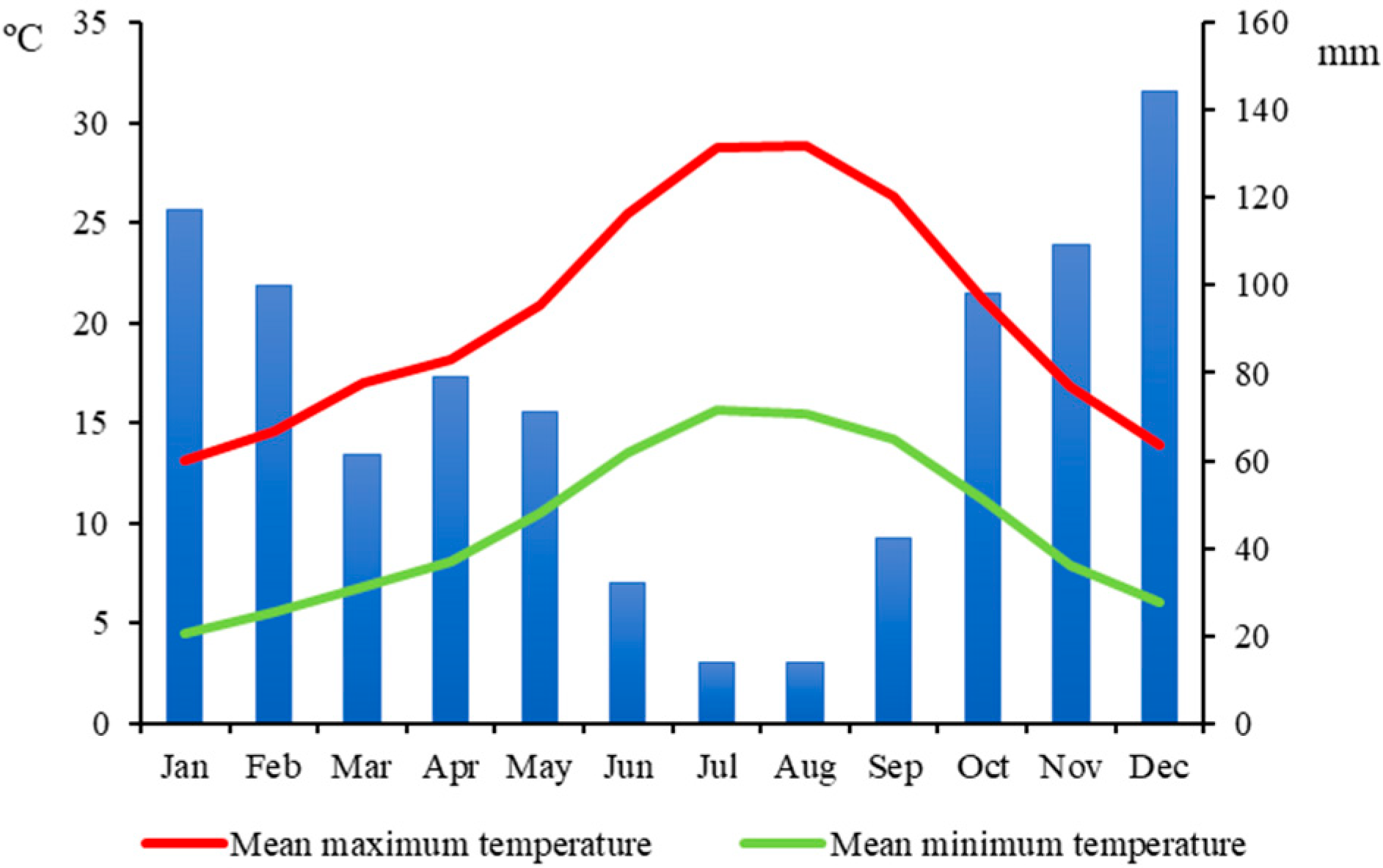
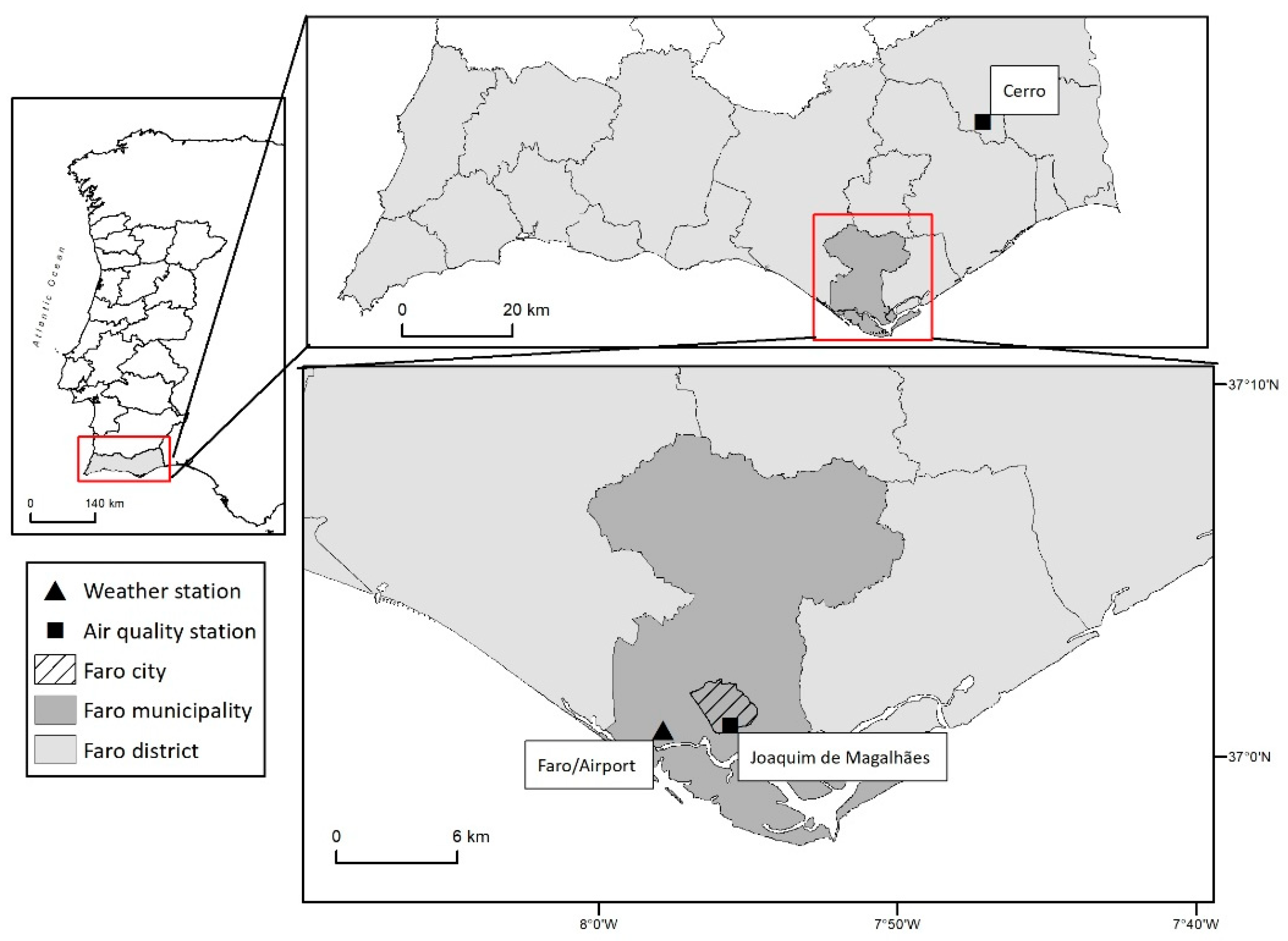
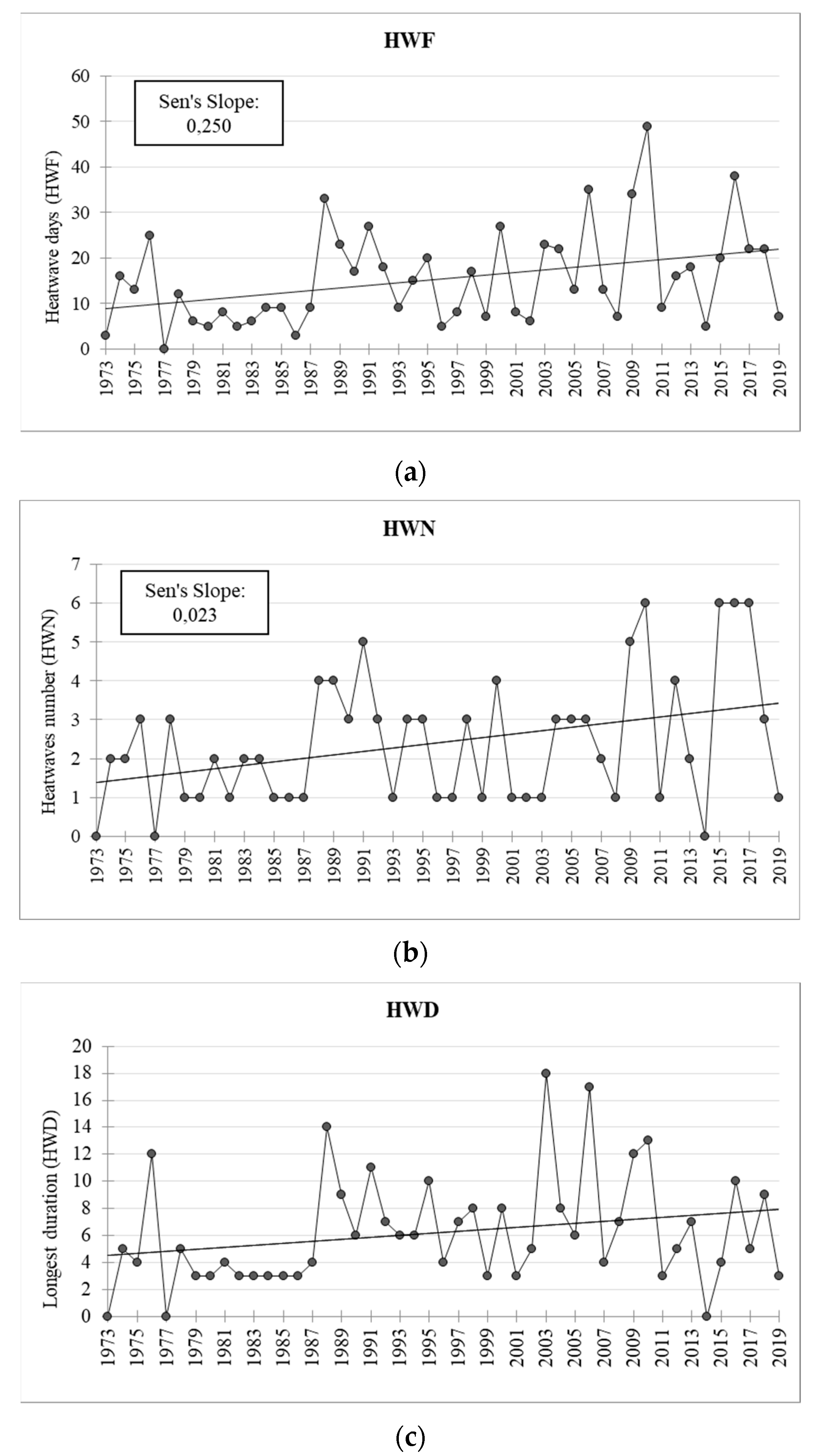
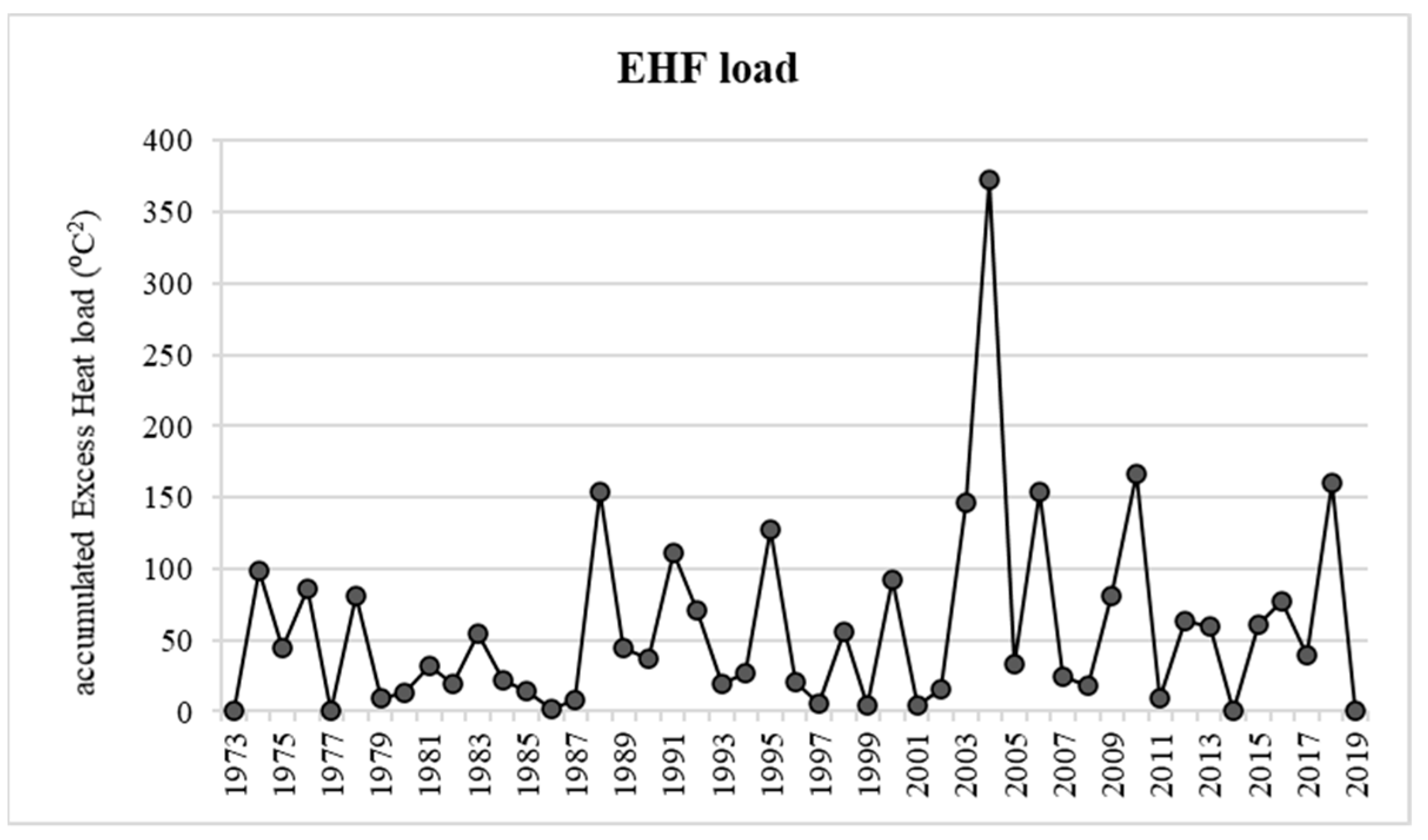
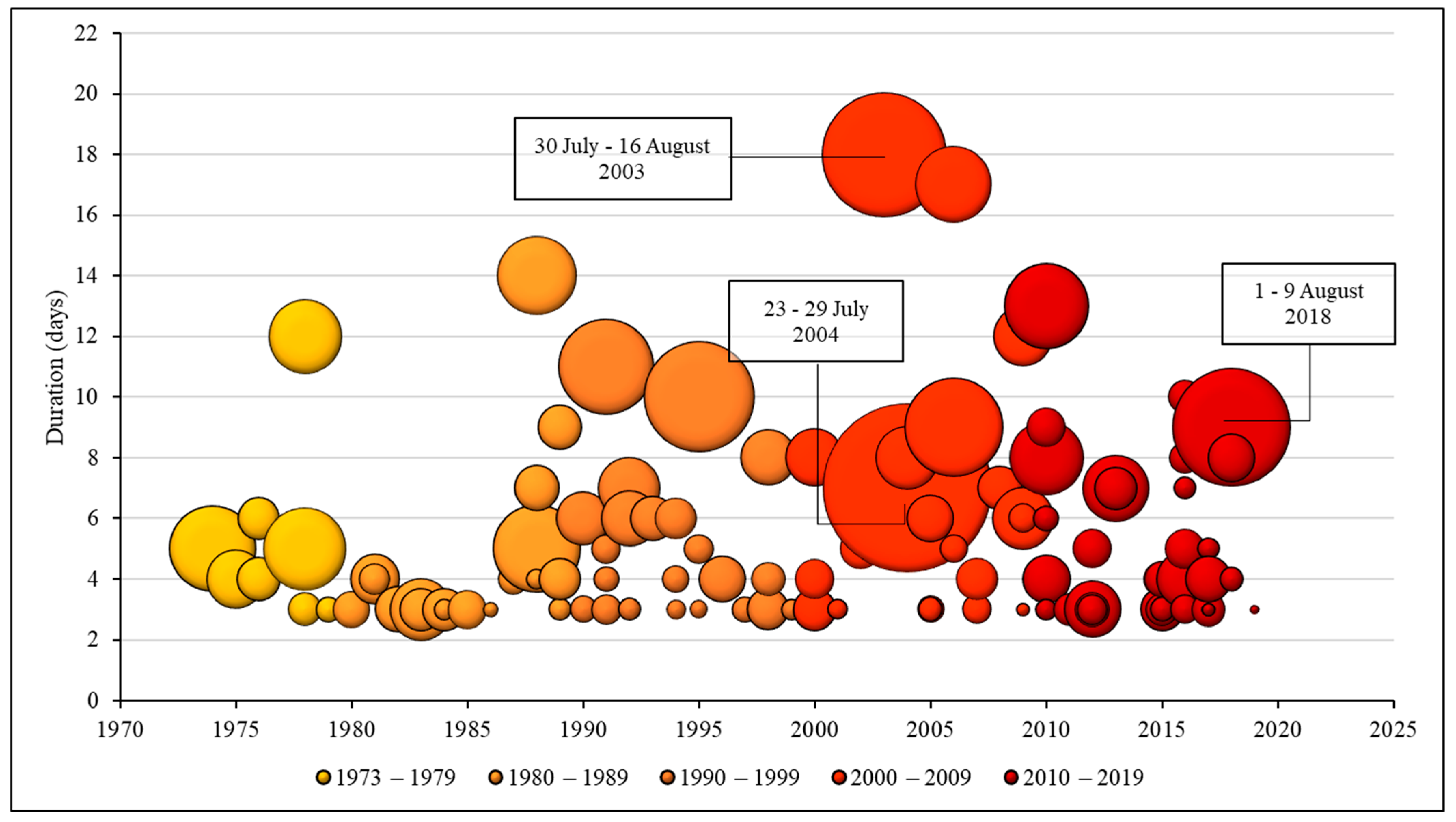
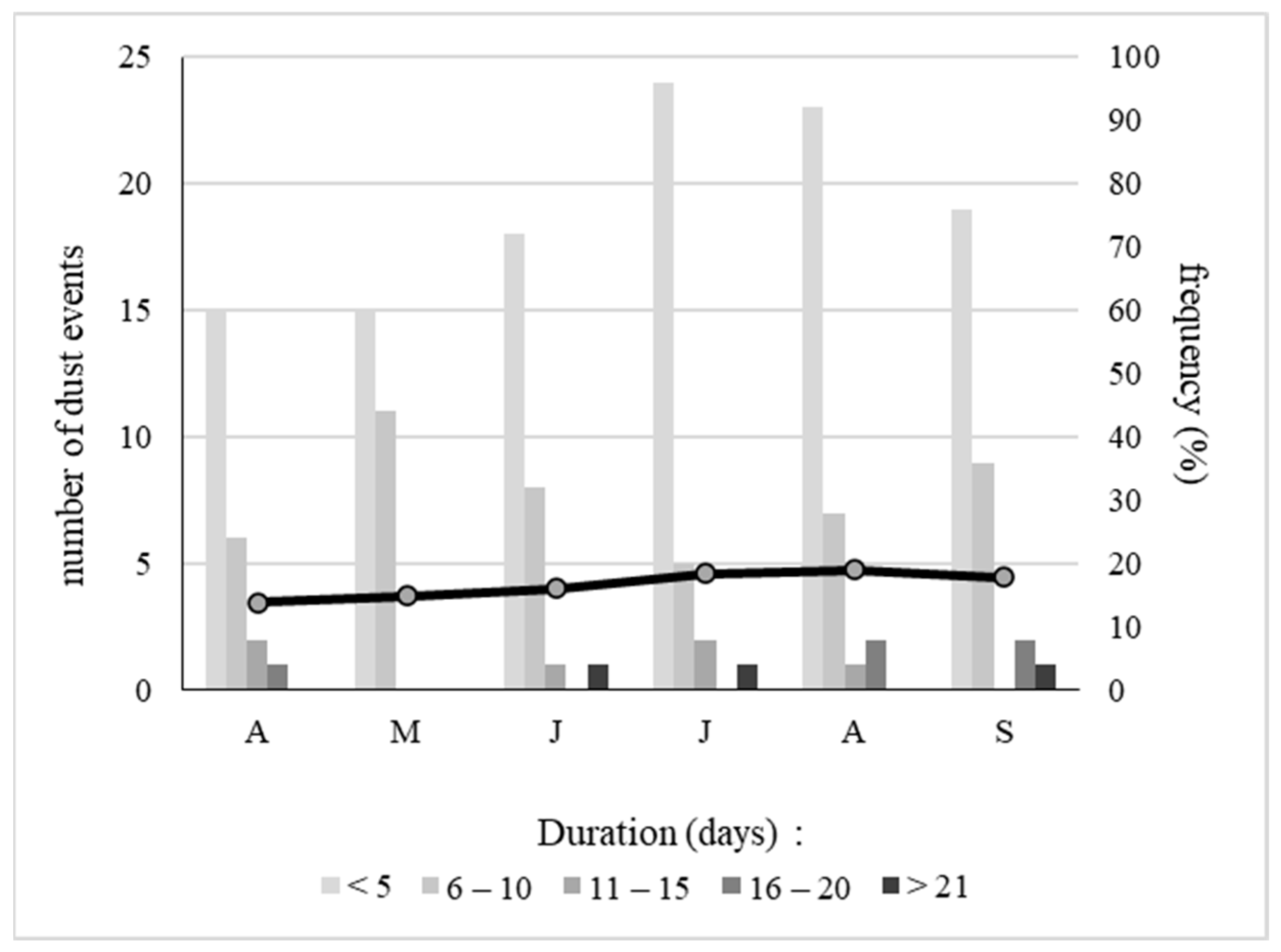
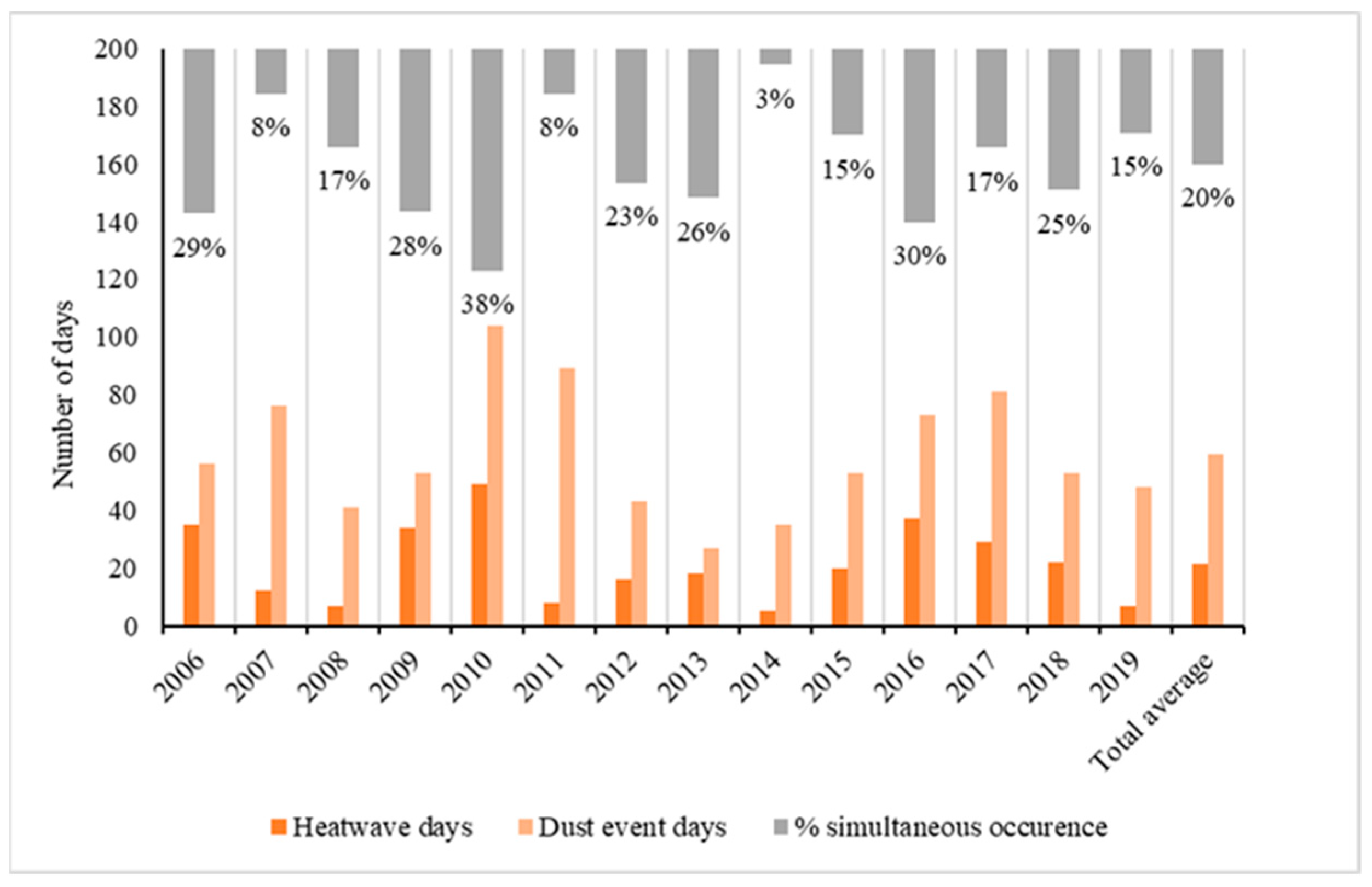
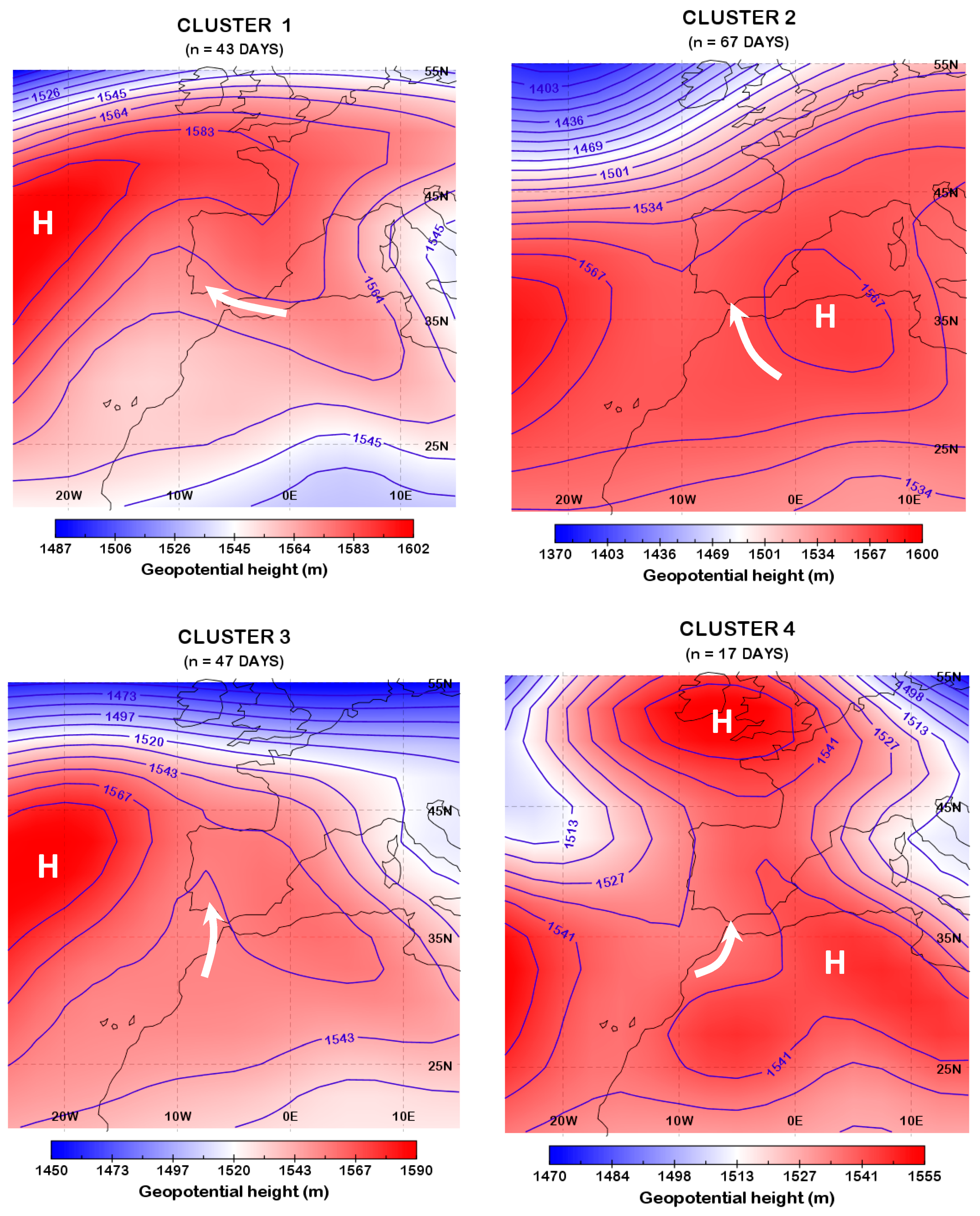
| Mann–Kendall Trend Test | |||
|---|---|---|---|
| Variable | Z | p-Value | Sen’s Slope |
| Heatwave days (HWF) | 2.43 | 0.015 | +0.250 |
| Heatwave number (HWN) | 2.04 | 0.041 | +0.023 |
| Longest heatwave duration (HWD) | 1.94 | 0.053 | +0.065 |
| EHF load | 1.09 | 0.065 | +0.507 |
| Joaquim de Magalhães | |||||
|---|---|---|---|---|---|
| Dust Events Days | Days with Average Value ≥ 50 µg/m3 | Average Hours ≥ 50 µg/m3 | Maximum Number of Consecutive Hours ≥ 50 µg/m3 | Highest Hourly Value µg/m3 | |
| April | 73 | 1 | 17 | 18 | 135.47 |
| May | 71 | 0 | 1 | 12 | 89.9 |
| June | 92 | 2 | 10 | 21 | 78.8 |
| July | 68 | 0 | 6 | 12 | 77.2 |
| August | 102 | 1 | 19 | 24 | 100.2 |
| September | 96 | 0 | 5 | 10 | 72.4 |
| Cerro | |||||
|---|---|---|---|---|---|
| Dust Events Days | Days with Average Value ≥ 50 µg/m3 | Average Hours with ≥ 50 µg/m3 | Maximum Number of Consecutive Hours ≥ 50 µg/m3 | Highest Hourly Value µg/m3 | |
| April | 73 | 8 | 27 | 21 | 244.2 |
| May | 71 | 0 | 2 | 5 | 76.9 |
| June | 92 | 3 | 7 | 22 | 91 |
| July | 68 | 0 | 6 | 8 | 119.2 |
| August | 102 | 5 | 23 | 24 | 129.9 |
| September | 96 | 0 | 0.2 | 1 | 50.7 |
Publisher’s Note: MDPI stays neutral with regard to jurisdictional claims in published maps and institutional affiliations. |
© 2021 by the authors. Licensee MDPI, Basel, Switzerland. This article is an open access article distributed under the terms and conditions of the Creative Commons Attribution (CC BY) license (https://creativecommons.org/licenses/by/4.0/).
Share and Cite
Fernandes, R.; Fragoso, M. Assessing Heatwaves and Their Association with North African Dust Intrusions in the Algarve (Portugal). Atmosphere 2021, 12, 1090. https://doi.org/10.3390/atmos12091090
Fernandes R, Fragoso M. Assessing Heatwaves and Their Association with North African Dust Intrusions in the Algarve (Portugal). Atmosphere. 2021; 12(9):1090. https://doi.org/10.3390/atmos12091090
Chicago/Turabian StyleFernandes, Raquel, and Marcelo Fragoso. 2021. "Assessing Heatwaves and Their Association with North African Dust Intrusions in the Algarve (Portugal)" Atmosphere 12, no. 9: 1090. https://doi.org/10.3390/atmos12091090
APA StyleFernandes, R., & Fragoso, M. (2021). Assessing Heatwaves and Their Association with North African Dust Intrusions in the Algarve (Portugal). Atmosphere, 12(9), 1090. https://doi.org/10.3390/atmos12091090






